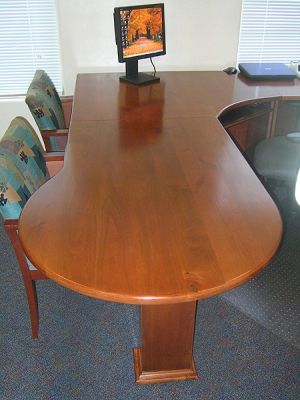Question
Our finisher just finished a kitchen and bath in a dark brown mahogany on red oak. When he shaded the doors, they had spray stripes which show, and with a trained eye I noticed the stripes. The customer has not said a thing about the stripes, only that the color looks great. Our finisher used a SprayTec 9200 turbine with cup HVLP gun and Valspar 550 voc lacquer. Can the finishing stripes be fixed?
Forum Responses
(Finishing Forum)
From contributor G:
If your customer thinks it looks great, don't disillusion them.
Are you saying that turbines don't heat the air? I think that breaks some of the laws of physics. My air compressor sure does get warm when it is running. I sure am glad the compressor is 150 feet away so the air cools off enough to get the moisture out. I've seen turbine guns that have a cushion on the handle because they get so warm. It has been many years since I've used one; maybe the technology has changed. I'm pretty sure the air is warmer coming out the turbine when the hose is only 20' long, compared to my gun that has its air supply 150' away.
Actually, air gains moisture as it cools. Even if a turbine does provide warmer air, it won't do much to warm the finish at the point of atomization.
I'm with you on wanting to fix it. Several things can cause stripes.
1. Be sure your finish viscosity is consistent with your spray setup. If it's too thick, marginal atomization can entrap micro-bubbles of air in the finish.
2. Use a retarder. If the finish skins over prematurely, you can get micro-bubbles of evaporated solvents trapped in the finish.
3. Be sure you get a consistent wet mil thickness. If your finish sheen is anything but gloss, the flatting agent will settle to the bottom of thick areas and remain near the top of thin areas. That causes differences in sheen which can appear as stripes.
If it's micro-bubbles you've got, they're hard to get rid of. If it's just inconsistent finish thickness, a consistent wet coat should fix it. Thinner is actually better.
There are a number of things which can cause the striping effect:
Too thick a viscosity for the spray setup.
Incorrect solvent used for temperature conditions. (Too fast evaporating.)
Too much air pressure at the gun.
Rushing the spray job, not keeping the passes close enough together.
Inexperienced sprayers. I see this all the time when cabinetmakers try to spray. They are so afraid of getting runs, they don't spray wet enough.
What caused the striping in your case? It could be any one or more of these things. On the bright side, you and your finisher will learn from the experience.
